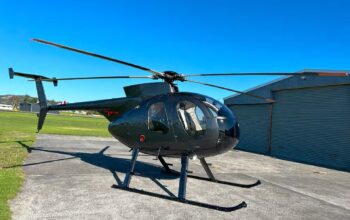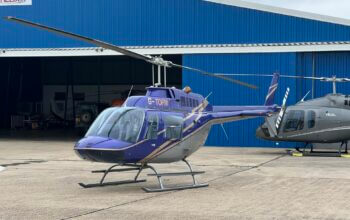Estimated reading time 11 minutes, 52 seconds.
Aircraft technologies that will reduce the nearly one billion tonnes of annual carbon emissions from fossil fuel use are urgently needed. While encouraging progress has been made in advancing electric and hydrogen-powered aircraft technologies, it will take a decade or more before these solutions become commercially viable for replacing fossil fuels. Sustainable aviation fuel (SAF), which is produced from renewable biomass feedstock, is the principal solution to decarbonize the aviation sector.
What is SAF and why is it beneficial?
SAF is a liquid fuel that is chemically similar to conventional jet fuel. SAF can be produced from a variety of feedstock such as oil-based waste cooking oils and inedible plant oils, carbon-based municipal solid waste including cardboard, clothing and food waste, and other agricultural cellulosic waste and algae.
Among the seven SAF production pathways approved by the American Society for Testing and Materials (ASTM) International, the hydroprocessed esters and fatty acids (HEFA) pathway is the most common for producing SAF. This pathway uses waste oils and animal fats to produce SAF. The Fischer-Tropsch (FT) process converts biomass to synthetic crude oil, which is refined to produce SAF. The alcohol-to-jet (AtJ) pathway converts sugars in biomass into isobutanol and ethanol, which are used to produce synthetic SAF using renewable energy. The power-to-liquid (PtL) process is a promising technology under development that will combine carbon dioxide captured directly from industrial emissions with sustainably generated hydrogen to produce SAF.

The diversity of biomass feedstocks available to produce SAF has significant benefits and mitigates the cost volatility currently experienced by aircraft operators due to the unpredictable fluctuations in crude oil prices. The use of certain feedstocks like municipal solid waste also provides the indirect benefit of reducing methane emissions from decomposition of waste in landfills.
The biggest advantage of SAF is that it is a “drop-in” fuel that can be blended with or completely replace conventional jet fuel without any airframe and engine modifications. This means that the tens of thousands of aircraft currently in operation around the globe — whether commercial, business aviation, etc. — as well as new aircraft produced now and in the near future, can already use SAF to offset carbon emissions. While SAF can be blended with jet fuel in ratios of up to 50 per cent, airframe manufacturers are working to ensure aircraft are 100 per cent SAF-compatible by 2030.
What are the global targets for SAF deployment?
In 2021, aviation became one of the few industries to adopt a climate goal of net-zero carbon emissions by 2050. Landmark legislation in Canada, the U.S., and Europe for SAF use is set to increase demand to 42 billion gallons (Bgal) by 2030. The EU’s ReFuelEU proposal aims to boost production of SAF by mandating a minimum volume of SAF in aviation fuel starting at two per cent in 2025 and increasing to 63 per cent in 2050.
The U.S. has a goal for domestic SAF production of at least 3 Bgal per year by 2030. The country also plans to replace 100 per cent of the domestic aviation fuel demand of around 35 Bgal per year with SAF by 2050. Canada’s aviation action plan, published in June this year, has laid out a roadmap for replacing 10 per cent of the projected aviation jet fuel use with SAF by 2030. This requires domestic production and use of 1 billion litres of SAF that will reduce lifecycle carbon emissions by 50 per cent, or roughly 1.6 million fewer tonnes.
Despite the technological advances since the first commercial test flight using SAF in 2008, and subsequent SAF adoption by many major airlines and engine manufacturers, there has been a lack of widespread use of SAF. In 2022, SAF production accounted for only 0.15 per cent of global jet fuel use. By 2030, production is expected to reach around 7 billion litres, or six to 10 per cent of the aviation fuel supply.
The 2030 SAF production level in the EU is projected to be 1.2 Bgal, lower than the 1.5 Bgal target. Similarly, the recent announcements for investments in the U.S. account for 2.2 Bgal of SAF compared to the projected target of 3 Bgal per year. In contrast to the EU and the U.S., there is currently no domestic SAF production in Canada. While companies have made announcements of plans to produce SAF, this accounts for only 500 million litres, fulfilling half of Canada’s 2030 SAF target of 1 billion litres.
Why has SAF not replaced fossil fuels yet?
A variety of factors are responsible for the modest uptake of SAF. As previously mentioned, SAF is currently produced predominantly from waste oils and fats using the HEFA pathway, which accounts for 80 and 66 per cent of all SAF production announced in Europe and the U.S., respectively. There is tremendous pressure on the waste oils market, which limits production capacity and increases the cost of SAF production from this feedstock. The AtJ pathway accounts for 27 per cent of proposed SAF production in the U.S. The use of other abundant feedstock sources is limited by lack of investments in technology and infrastructure development for scaling up production using other chemical pathways.
Perhaps the most important factor limiting SAF adoption is cost. A lack of large-scale production contributes to the high cost of SAF. While it can be delivered through the existing fuel distribution infrastructure, the resources and supply chains for scaling up production are limited.
Investments are necessary for the development of technologies that use low-cost feedstock sources, and for building new SAF refineries to scale up production. In the U.S. alone, 250 SAF refineries are needed, requiring a substantial investment of US$400 billion.
Policy measures that reduce investment risks, incentives for infrastructure development, and sustainable production pipelines are critical for achieving the planned transition to SAF as part of the aviation industry’s net-zero goals.
What is the future of SAF production?
Prior to the pandemic, the commercial aviation industry consumed around 360 billion litres (95 Bgal) of jet fuel annually. As passenger volumes return to pre-pandemic levels, there is no question that SAF will play a pivotal role in reducing carbon emissions in the aviation industry.
The first step towards widespread adoption of SAF is streamlining large-scale production of SAF. This scale up hinges on expanding the production and supply of sustainable biomass feedstock. Estimates suggest that the U.S. can produce 50 to 60 Bgal of advanced biofuels from domestically grown biomass without major disturbance to the existing agriculture and trade sectors. Canada has sufficient sustainable biomass to produce seven to 10 billion litres of SAF annually. If this biomass is prioritized for aviation, this is the amount of fuel required to meet the total domestic demand for 2030. Canada also has access to clean electricity to produce SAF using green hydrogen and carbon captured from industrial emissions.
Incentives that promote SAF production from diverse feedstocks are critical to reducing the cost and promoting SAF adoption by aircraft operators. The Inflation Reduction Act (IRA) in the U.S., signed into law by President Biden in 2022, provides a three-year SAF production tax credit which starts at US$1.25/gallon for SAF that offsets 50 per cent of lifecycle carbon emissions. This increases for every per cent reduction in emissions for a maximum of US$1.75/gallon of SAF produced. The IRA also introduced a US$290 million grant over four years to support projects that produce, transport, blend, and store SAF and advance low-emission aviation technologies.
For its part, Canada launched the “Sky’s the Limit Challenge” in collaboration with industry partners, including Air Canada and WestJet. This national competition was an effort to solve problems of availability and affordability of SAF in Canada. The four finalists — Enerkem (winner), SAF+ Consortium, Forge Hydrocarbons, and Carbon Engineering — each received up to C$2.15 million in awards to refine their project ideas and attract investment in SAF production technology development in Canada.
While these are promising steps, clear policy measures and funding to support the production and use of low-cost feedstocks, as well as development of technologies to scale-up production, are critical for widespread domestic production of SAF in Canada.
Decarbonizing the aviation sector requires a long-term vision for scaling up production and increasing cost competitiveness of SAF. Governments and industries must work collaboratively to create the necessary innovation ecosystem. Policies must be created to incentivize increasing feedstock supply while reducing cost; national and regional value chains must be established; and technology and supply chains must advance in order to scale up production. These specific initiatives will facilitate SAF availability at competitive prices for widespread adoption by aircraft operators to meet the growing demand for a greener aviation industry.








